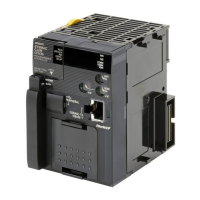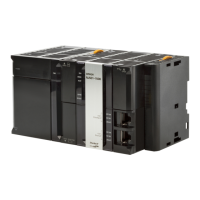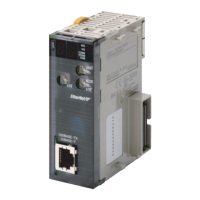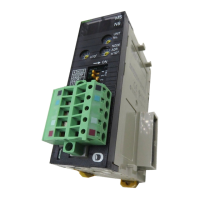
Do you have a question about the Omron CJ2M-CPU35 and is the answer not in the manual?
| Model | CJ2M-CPU35 |
|---|---|
| Power Supply Voltage | 24 VDC |
| Power Supply | 24 VDC |
| Operating Temperature | 0 to 55 °C |
| Number of I/O Points | 2560 |
| Instruction Execution Speed (Basic) | 0.04 μs |
| Serial Port | 1 |
| Ethernet Port | 1 |
| Pulse I/O | Yes |
| High-speed Counter | Yes |
| Humidity | 10 to 90% |
| Dielectric Strength | 2, 300 V AC for 1 minute |
| Insulation Resistance | 20 MΩ |
| I/O Capacity | 2560 points |
| Vibration Resistance | 10 to 57 Hz, 0.075mm amplitude, 57 to 150 Hz, 9.8 m/s² acceleration |
| Shock Resistance | 150 m/s**2 3 times each in X, Y, and Z directions |
Lists the specific OMRON devices, including CPU Units, Serial Communications Units, and Displacement Sensors, that are applicable.
Details the hardware components and their configuration required for the connection procedures.
Details the specific parameter settings required for PLC and Sensor Controller serial communication.
Provides connector configurations, pin assignments, and cable wiring details for serial communication.
Presents a high-level workflow for connecting the PLC to the Sensor Controller and performing send/receive operations.
Details the steps for setting up the Sensor Controller, including hardware connections and parameter settings.
Guides on connecting cables and other hardware components to the Sensor Controller.
Details the steps to set parameters for the Sensor Controller using its interface.
Provides instructions for setting up the PLC, including hardware configuration and cable connections.
Details setting hardware switches on the Serial Communications Unit and connecting cables.
Guides on starting CX-Programmer, opening a project file, and establishing an online connection with the PLC.
Details the process of creating the I/O table for the PLC within CX-Programmer.
Explains how to set parameters for the Serial Communications Unit using the PLC IO Table.
Guides on transferring the project data from CX-Programmer to the PLC.
Details how to start CX-Protocol and open the relevant project file for communication setup.
Describes how to start the send/receive processing and confirm that serial communications are functioning normally.
Explains how to start tracing in CX-Protocol to monitor serial communication activity.
Describes how to execute the communications sequence using CX-Programmer's ladder logic.
Guides on checking the trace data in CX-Protocol to confirm correct data transmission and reception.
Explains how to check if the correct data is written to the PLC's I/O memory using CX-Programmer.
Details the steps to initialize the PLC, including Serial Communications Unit and CPU Unit settings.
Guides on initializing the Serial Communications Unit settings via CX-Programmer.
Explains how to clear all memory areas for the CPU Unit in CX-Programmer.
Explains the program's purpose: checking the connection using protocol macros and detecting normal/error ends.
Illustrates the data flow from PLC issuing commands to receiving responses from the Sensor Controller.
Details the basic operations of the PMCR instruction for sending and receiving messages.
Explains the communications sequences used for the PMCR instruction, including sequence numbers.
Defines how communications sequences are identified and used in PMCR instructions.
Details the operand settings for the PMCR instruction for version information acquisition.
Describes the error detection mechanisms for PMCR instruction errors, communication errors, and destination device errors.
Shows the memory maps used by the program, including input and output memory addresses.
Lists the specific addresses necessary for program execution and provides a note on avoiding duplicate addresses.
Details the internal memory addresses used by the program for PMCR instruction status and parameters.
Lists CIO area and related auxiliary area addresses used by the program.
Describes the functional components of the ladder program, categorized by major classification.
Breaks down the ladder program into initialization, PMCR instruction management, normal end, and error end state management.
Provides a detailed breakdown of the program's functional components, including initialization and operand settings.
Covers PMCR instruction execution status, processing, and related flags.
Details how the program detects normal or error ends of send/receive processing.
Manages the normal end state, including setting the normal completion flag and response code.
Manages the error end state, including setting the error flag and response code.
Describes the composition of protocol macro data, including sequence, step, and message formats.
Explains the structure of protocol macro data, including send/receive messages and receive matrices.
Outlines the processing flow for protocol macro data, including normal and error handling.
Details the sequence settings for version information acquisition, including timeout periods.
Describes step settings for communications sequence, including retry count and message names.
Details the settings for send messages, including command format and remarks.
Sets receive message formats compatible with normal and error responses.
Describes receive matrix settings, used to compare receive messages with specified conditions.
Presents timing charts illustrating normal and error end scenarios of the communication process.
Details errors that can occur during program execution, including PMCR errors and destination device errors.
Lists and explains error codes related to PMCR instruction and communication errors.











